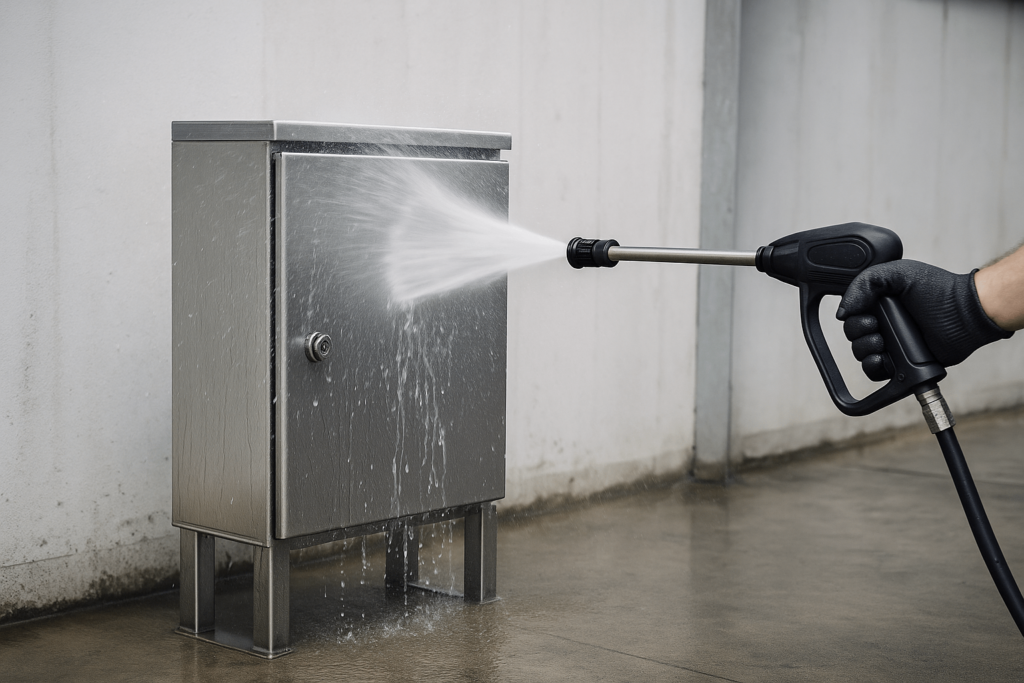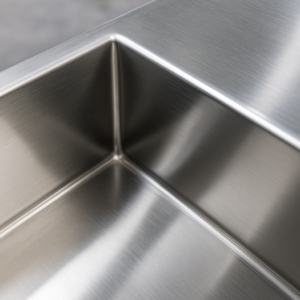Navigating NEMA 4X vs. IP69K, Material Science, and Hygienic Design to Maximize Long-Term Value and Minimize Risk
Introduction: A Costly Mistake in Sourcing
For a distributor, a product failure at a customer’s site is more than an inconvenience—it’s a chain reaction of warranty claims, damaged reputation, and strained client relationships.
Imagine a state-of-the-art food processing facility at 3 a.m. A critical production line halts due to a failed electrical enclosure—one you supplied. This scenario isn’t just a technical glitch—it’s a sourcing risk with business-wide consequences.
This guide goes beyond basic specifications. It is crafted for overseas wholesale buyers and project contractors needing reliable, compliant, and value-driven washdown enclosures.
We explore pivotal sourcing decisions that impact long-term performance, compliance, and procurement credibility.
Chapter 1: Understanding the End-User’s Environment: The Four “Invisible Killers” in Washdown Zones
A strategic sourcing strategy begins with understanding real-world operating environments. In industrial washdown zones, enclosures face multiple overlapping threats.
Recognizing these four environmental forces is essential to specifying durable, high-performance products.

The High-Pressure Assault
The most obvious threat is forceful high-pressure water jets, often exceeding 1,450 PSI (100 bar).
This is more than cleaning—it’s an ongoing physical challenge that puts seal integrity under stress. Weak points can result in gasket blowouts and water ingress.
The Chemical Warfare
Industrial cleaning protocols involve corrosive substances like caustic alkalis and chlorinated sanitizers.
Designed to kill bacteria, these agents also corrode inadequately specified materials. Chemical resistance is therefore a critical spec criterion.
The Thermal Shock
Hot water cycles reaching 80°C (176°F) trigger abrupt temperature swings.
These fluctuations cause material expansion and contraction, weakening gasket adhesion and reducing enclosure lifespan.
The Microbial Invasion
In sanitary production lines, electrical enclosures must not become contamination points.
Design flaws—like exposed hardware or crevices—harbor bacteria. Smooth, crevice-free design is a must for regulated industries.
Chapter 2: Decoding Global Standards: NEMA vs. IP Ratings for Market Compliance
International wholesale buyers must understand enclosure protection classifications to prevent cross-market mismatches.
NEMA and IP ratings—based on NEMA 250 and IEC 60529—differ in methodology and application.
The IP67 vs. IP66 Misconception: A Common Sourcing Pitfall
Many assume IP67 is superior to IP66 for washdown—but this reflects a misunderstanding of testing focus.
- IP67: Validates short-term immersion in 1m of water—a passive scenario.
- IP66: Validates high-pressure water jets—closer to actual industrial washdown.
In real applications involving hose-directed cleaning, IP66 is the more suitable specification.
The Strategic Showdown: NEMA 4X vs. IP69K
High-risk environments often require NEMA 4X and IP69K—but each addresses different conditions.
- NEMA 4X: Focuses on corrosion resistance and jet protection, validated with a 200-hour salt spray test.
- IP69K: Tests against 80°C high-pressure jets—ideal for food, pharma, and beverage sectors.
High-risk environments frequently demand both—IP69K for process survivability, NEMA 4X for external corrosion resilience.
Quick-Reference Data Table: NEMA vs. IP Rating Comparison
| Test Parameter | NEMA 4 / 4X | IP66 | IP67 | IP69K |
|---|---|---|---|---|
| Test Type | Hose-Directed Water | Powerful Water Jets | Temporary Immersion | High-Pressure, High-Temp Jets |
| Water Pressure | Not specified | 100 kPa (~14.5 psi / 1 bar) | N/A (Hydrostatic) | 8,000-10,000 kPa (1160-1450 psi / 80-100 bar) |
| Water Temperature | Ambient | Ambient | Ambient | 80°C (176°F) |
| Corrosion Test | Yes (NEMA 4X) | No | No | No |
Data based on NEMA 250 and IEC 60529 standards.
Chapter 3: Material Strategy for Electrical Enclosures: Choosing the Right Steel
Material selection affects both enclosure performance and total cost of ownership. B2B buyers must assess not just price, but environmental compatibility.
304 vs. 316L Stainless Steel: The Molybdenum Factor
The primary difference between 304 and 316L stainless lies in corrosion performance due to molybdenum content.
- 304 Stainless: Common in general environments but susceptible to pitting corrosion in chloride-heavy zones.
- 316L Stainless: With 2-3% molybdenum, it resists high chloride levels—suitable for sanitation-intensive and coastal industries.
Economic Logic: Total Cost of Ownership (TCO)
Though 316L costs more upfront, it reduces costs from corrosion failures, maintenance, and system downtime.
Over a project lifecycle, 316L often delivers a superior ROI, especially in food, chemical, and marine applications.
Other Material Options: Polycarbonate & Fiberglass Use Cases
Alternatives to stainless steel include:
- Polycarbonate Enclosures: Ideal for dry indoor settings and light-duty washdowns.
- Fiberglass Enclosures: Chemical-resistant but brittle—less ideal for environments with impact or hygiene requirements.
Chapter 4: Designing for Hygiene: Cleanability as an Engineering Standard
In regulated industries, sanitary design ensures product safety and compliance.
These features reflect supplier expertise in fabrication and understanding of hygiene-critical zones.

Sloped Top Advantage
A 15–30° top slope promotes water runoff and discourages storage of tools—two hygiene wins.
This simple design choice reduces bacterial risk and simplifies sanitation.
Seamless Finish and Polished Welds
High-performance enclosures feature smooth welds and polished corners to prevent debris buildup.
A #4 dairy finish (Ra < 0.8 µm) meets food industry cleanability benchmarks.
Small Details, Big Impact
- Internal hinges avoid contamination exposure.
- Flush latches and FDA-grade blue gaskets offer safety and easy visual detection.
- Standoffs and wall gaps support clean installation—aligned with 3-A Sanitary Standards.
Chapter 5: Application Snapshots: When Sourcing Goes Right (or Wrong)
Real-world case studies validate correct sourcing decisions—and expose costly oversights.
Dairy Facility: Withstanding Aggressive Cleaning
In a daily CIP environment:
- IP69K protects from pressurized hot water.
- NEMA 4X shields from chemical attack.
- 316L stainless delivers resistance and durability.
Pharmaceutical Lab: Meeting Sterilization Protocols
Cleanroom projects require:
- Electropolished 316L with no particulate shedding.
- Compatibility with VHP and cGMP standards.
Marine Platform: When the Wrong Box Fails
Failures occurred due to:
- Using NEMA 4 instead of 4X.
- Choosing 304 steel in high-chloride air.
- Employing mixed-metal components—leading to galvanic corrosion.
Conclusion: Strategic Checklist for B2B Enclosure Sourcing
Use this 5-point checklist to streamline global sourcing:
- Environment Check: Define pressure, heat, and chemical exposure.
- Compliance Mapping: Verify IP/NEMA needs, food/pharma standards.
- Rating Selection: Use IP69K for high-temp washdowns, NEMA 4X for corrosion.
- Material ROI: Favor 316L for sanitation and coastal projects.
- Supplier Capability: Look for weld quality, clean design, and technical support.
Want a quote or technical recommendation?
Contact YISHANG—a RoHS & ISO 9001-certified metal fabrication specialist with 26+ years of OEM/ODM experience in custom enclosures for food, marine, and medical-grade projects.

